Papers by Charles Lockwood

The Journal of Clinical Endocrinology and Metabolism, Mar 1, 1998
Decidualization of estradiol (E 2)-primed human endometrial cells (HESCs) by progesterone is asso... more Decidualization of estradiol (E 2)-primed human endometrial cells (HESCs) by progesterone is associated with elevated levels of tissue factor (TF), the primary initiator of hemostasis. Similarly, in cultured human HESCs, the synthetic progestin, medroxyprogesterone acetate (MPA), enhances TF protein and messenger ribonucleic acid (mRNA) levels. Although ineffective alone, E 2 potentiates this progestin enhancement of TF expression by HESCs. The current study examines mechanisms underlying MPA enhancement of TF mRNA expression in HESCs. In the presence of the transcription-blocking agent dichlororibofuranosylbenzimidazole, no significant differences were noted in the half-lives of TF mRNA isolated from HESCs treated with E 2 alone or with E 2 plus MPA. This indicates that MPAenhanced TF mRNA levels do not reflect changes in the stability of the TF message. To test the effect of progestin on TF promoter activity and to ascertain the mechanism of promoter regulation, primary or first passaged HESCs were transfected with TF promoter constructs spanning the regions Ϫ2106 to ϩ121 (TFp Ϫ2106), Ϫ278 to ϩ121 (TFp Ϫ278), and Ϫ111 to ϩ14 (TFp Ϫ111) bp upstream of the transcription start site. MPA was found to enhance TF transcription by 20-fold in HESCs transfected with TFp Ϫ2106 after correcting for transfection efficiencies with a -galactosidase reporter plasmid. Interestingly, levels of E 2plus MPA-stimulated transcription were significantly increased using TFp Ϫ278 compared to TFp Ϫ2106 , suggesting that the region between Ϫ2106 and Ϫ278 bp may contain an inhibitory element. In addition, rates of MPA-stimulated transcription using TFp Ϫ111 were significantly reduced compared to values obtained using TFp Ϫ2106 and were even further reduced compared to values obtained using TFp Ϫ278. This suggests that regulatory elements in the Ϫ111 bp region of the TF promoter are necessary for progestin-mediated regulation of the TF gene in HESCs, but are not sufficient to account for maximal rates of TF gene transcription. Our results also demonstrated that induction of steady state TF mRNA by MPA was abolished by treating cells with E 2 plus MPA in conjunction with the protein synthesis inhibitor cycloheximide. In light of the absence of a complete progesterone or estrogen response element in the published 5Ј-sequence of the TF promoter, our results suggest that progestin-enhanced transcription of TF mRNA in stromal cells may be mediated by an uncharacterized protein intermediate(s).

American Journal of Pathology, Sep 1, 2015
Sustained plasma progesterone (P4) levels suggest initiation of human term labor by functional P4... more Sustained plasma progesterone (P4) levels suggest initiation of human term labor by functional P4 withdrawal, reflecting reduced progesterone receptor (PR) and/or glucocorticoid receptor (GR) expression or activity. The steroid-induced immunophilin cochaperone FKBP51 inhibits PR-and GR-mediated transcription, suggesting a labor-initiating role. Gestational ageematched decidual sections were immunostained for FKBP51 and decidual cell (DC) and interstitial trophoblast (IT) markers, vimentin and cytokeratin, respectively. Term DC cultures were incubated with vehicle (control), estradiol (E 2) with or without medroxyprogesterone acetate, dexamethasone (Dex), or Organon 2058. FKBP51 histologic scoring was significantly higher in DC nuclei during labor versus prelabor decidua, whereas FKBP51 immunostaining was undetected in interstitial trophoblasts (P < 0.05). In term DC cultures, E 2 þ medroxyprogesterone acetate or E 2 þ Dex enhanced FKBP51 expression (P < 0.01), whereas E 2 þ Organon 2058 inhibited PR expression (P < 0.05), and E 2 þ Dex inhibited GR expression (P < 0.05). Unlike term DCs, FKBP51 was undetected in control or Dex-treated cultured third-trimester trophoblasts. Electrophoretic mobility shift assays revealed that FKPB51 overexpression or silencing in cultured DCs altered PR-DNA binding. Increased FKBP51 levels in term DCs during labor complement our prior in situ observations of significantly lower PR in labor versus prelabor DCs. In a milieu of sustained plasma P4 levels, these reciprocal changes will amplify functional P4 withdrawal in DCs via FKBP51-mediated PR resistance coupled with declining PR levels, whereas the lack of FKBP51 expression in interstitial trophoblasts suggests unopposed constitutive GR action.
Informa Healthcare eBooks, Apr 1, 2008

The Journal of Clinical Endocrinology and Metabolism, Oct 1, 2014
Despite the absence of progesterone receptor protein in human endometrial endothelial cells (HEEC... more Despite the absence of progesterone receptor protein in human endometrial endothelial cells (HEECs), endometria of women receiving long-acting progestin-only contraceptives (LAPCs) display reduced uterine blood flow, elevated reactive oxygen species generation, increased angiogenesis, and irregularly distributed, enlarged, fragile microvessels resulting in abnormal uterine bleeding. We propose that paracrine factors from LAPC-treated human endometrial stromal cells (HESCs) impair HEEC functions by shifting the balance between HEEC viability and death in favor of the latter. Proliferation, apoptosis, and transcriptome analyses were performed in HEECs treated with conditioned medium supernatant (CMS) derived from HESCs treated with estradiol (E2) ± medroxyprogesterone acetate or etonogestrel under normoxia or hypoxia. Mass spectrometry interrogated the CMS secretome while immunostaining for neuronal pentraxin-1 (NPTX1), cleaved caspase-3, and cytochrome c was performed in cultured HEECs and paired endometria from women using LAPCs. HEEC apoptosis and its underlying mechanism. HESC CMS from E2 + medroxyprogesterone acetate or E2 + etonogestrel incubations under hypoxia induced HEEC apoptosis (P &amp;amp;lt; .05), whereas mass spectrometry of the CMS revealed increased NPTX1 secretion (P &amp;amp;lt; .05). Endothelial cleaved caspase-3 and stromal NPTX1 immunoreactivity were significantly higher in LAPC-treated endometria (P &amp;amp;lt; .001). Transcriptomics revealed AKT signaling inhibition and mitochondrial dysfunction in HEECs incubated with HESC CMS. In vitro analyses proved that CMS decreased HEEC AKT phosphorylation (P &amp;amp;lt; .05) and that recombinant NPTX1 (P &amp;amp;lt; .05) or NPTX1 + H2O2 (P &amp;amp;lt; .001) increase HEEC apoptosis and cytosolic cytochrome c levels. LAPC-enhanced NPTX1 secretion and reactive oxygen species generation in HESCs impair HEEC survival resulting in a loss in vascular integrity, demonstrating a novel paracrine mechanism to explain LAPC-induced abnormal uterine bleeding.
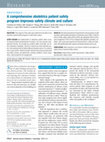
Obstetric Anesthesia Digest, Mar 1, 2012
The purpose of this study was to determine the effect of an obstetrics patient safety program on ... more The purpose of this study was to determine the effect of an obstetrics patient safety program on staff safety culture. STUDY DESIGN: We implemented (1) obstetrics patient safety nurse, (2) protocol-based standardization of practice, (3) crew resource management training, (4) oversight by a patient safety committee, (5) 24hour obstetrics hospitalist, and (6) an anonymous event reporting system. We administered the Safety Attitude Questionnaire on 4 occasions over 5 years (2004-2009) to all staff members that assessed teamwork and safety cultures, job satisfaction, working conditions, stress recognition, and perceptions of management. RESULTS: We observed significant improvements in the proportion of staff members with favorable perceptions of teamwork culture (39% in 2004 to 63% in 2009), safety culture (33% to 63%), job satisfaction (39% to 53%), and management (10% to 37%). Individual roles (obstetrics providers, residents, and nurses) also experienced improvements in safety and teamwork, with significantly better congruence between doctors and nurses. CONCLUSION: Safety programs can improve workforce perceptions of safety and an improved safety climate.
The Journal of Clinical Endocrinology and Metabolism, 1996

Endocrinology, Sep 1, 1993
Increased levels of glucocorticoids are associated with human parturition whether occurring befor... more Increased levels of glucocorticoids are associated with human parturition whether occurring before or at term. In the present study we examined the effects of glucocorticoids on placental fibronectin (FN) expression in cytotrophoblasts, isolated from human term placentas, to provide a potential mechanism through which glucocorticoids may influence uterine-placental adherence near parturition. Based on immunoassays, relative to controls, media levels of placental FNs bearing an oncofetal epitope (onfFN) were inhibited 65-80% by treatment with 10(-7) M dexamethasone (DEX) during experiments in which cumulative levels and daily release of onfFN were measured. DEX treatment increased human CG production by cytotrophoblasts approximately 3-fold without affecting the levels of total protein, suggesting that DEX treatment did not reduce placental function. DEX and cortisol inhibited onfFN expression with an EC50 of 2 and 16 nM, respectively. Other steroids were not effective in down-regulating onfFN expression, indicating that this was a glucocorticoid-specific response. In immunoprecipitation studies, treatment of cytotrophoblasts with 10(-7) M DEX for 3 days inhibited both release of labeled FN to the media and its incorporation into cell-associated material by approximately 80%. Results from Northern blotting indicated that DEX treatment suppressed levels of FN messenger RNA approximately 90% relative to controls. Levels of labeled laminin in media were inhibited approximately 80% by a 3-day treatment with 10(-7) M DEX, suggesting that glucocorticoids may coordinately suppress the synthesis of multiple extracellular matrix proteins in cytotrophoblasts. In our model, we propose that glucocorticoids may suppress placental extracellular matrix protein synthesis, which could lead to decreased uterine-placental adherence and be associated with parturition.
Journal of Immunology, Dec 1, 2020
The anti-infective Nitazoxanide shows strong immumodulating effects (155.21)
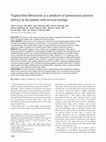
American Journal of Obstetrics and Gynecology, Nov 1, 2003
The purpose of this study was to assess the validity of vaginal fetal fibronectin as a screening ... more The purpose of this study was to assess the validity of vaginal fetal fibronectin as a screening test for spontaneous preterm birth in patients with cervical cerclage. STUDY DESIGN: A historic cohort of 117 patients who underwent cervical cerclage placement between 1996 and 2002 were identified. All patients were followed up in a maternal-fetal medicine faculty practice in a university setting. Serial fetal fibronectin samples of vaginal secretions were collected every 2 to 3 weeks, starting at 22 weeks of gestation and continuing until 32 weeks or delivery, whichever came first. RESULTS: There were 81 singleton, 23 twin, 12 triplet, and 1 quadruplet pregnancies. There were 61 ultrasound-indicated, 47 prophylactic, and 9 emergency cerclages that were placed. Most cerclages were of the modified Shirodkar type (95%) with a median gestational age at cerclage placement of 16.6 weeks. Overall, 33.3% of gestations were delivered spontaneously before 37 weeks of gestation; 17.1% of gestations were delivered spontaneously before 34 weeks. For deliveries within 2 weeks and 3 weeks of a single fetal fibronectin assessment, the test had a sensitivity of 50% and 48.3%, a specificity of 90% and 91.1%, a positive predictive value of 16.3% and 28.6%, and a negative predictive value of 97.9% and 96%, respectively. Subgroup analysis by number of fetuses (singleton, twin, and higher order multiple gestations) revealed similar values. For delivery before 34 weeks of gestation, fetal fibronectin had a sensitivity of 50%, a specificity of 78.4%, a positive predictive value of 33.3%, and a negative predictive value of 88%. CONCLUSION: This study is the first to evaluate the use of vaginal fetal fibronectin assessments to screen for preterm birth in patients who had undergone cervical cerclage procedures. We conclude that this test has similar validity to predict spontaneous preterm delivery in these high-risk pregnancies, as in previously published cohorts.
Molecular Endocrinology, Mar 1, 2000

The Journal of Clinical Endocrinology and Metabolism, Sep 1, 1994
Despite the pronounced hemorrhagic effects of RU 486 administration on luteal phase and early ges... more Despite the pronounced hemorrhagic effects of RU 486 administration on luteal phase and early gestational endometrium, no information is available on the effect of RU 486 on endometrial hemostatic potential. The expression of endometrial stromal cell tissue factor (TF), the primary initiator of hemostasis, has been shown to be progestationally regulated in vivo and in vitro. To evaluate the effects of RU 486 on progestin-enhanced TF expression, confluent stromal cell cultures derived from proliferative phase endometria were exposed to vehicle control, 10(-8) mol/L estradiol (E2), 10(-6) mol/L dexamethasone, 10(-7) mol/L medroxyprogesterone acetate (MPA), E2 plus MPA, E2 plus 10(-6) mol/L progesterone (P), or 10(-6) mol/L RU 486 alone or with E2 plus MPA or E2 plus P for 3-4 days. Compared to the vehicle control, E2, dexamethasone, and RU 486 alone had no effect on the content of immunoreactive and functionally active TF protein, whereas MPA increased and the combination of E2 and MPA further increased TF protein content. Similarly, E2 and P enhanced the stromal cell TF content. These progestin effects were blocked by RU 486. Similar results were obtained for steady state TF messenger ribonucleic acid (mRNA) levels. Possible RU 486-mediated reversal of progestin-enhanced stromal cell TF expression was assessed by incubating confluent cultures in E2 plus MPA for 3-10 days to enhance TF content, then washing the cultures and reexposing them to either E2 plus MPA or to RU 486 alone or with E2 plus MPA for 3, 4, or 7 days. Exposure to RU 486 alone or with E2 plus MPA greatly reduced levels of stromal cell TF protein and mRNA expression compared to those in cultures maintained in E2 plus MPA. These findings demonstrate that RU 486 not only blocks but also reverses in vitro progestin-enhanced stromal cell TF protein and mRNA expression, suggesting an additional mechanism for RU 486-induced menses and early abortion.
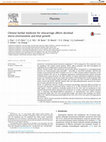
Placenta, May 1, 2015
Introduction: Intrauterine growth restriction complicates 5e10% of pregnancies. This study aims t... more Introduction: Intrauterine growth restriction complicates 5e10% of pregnancies. This study aims to test the hypothesis that Chinese herbal formula, JLFC01, affects pregnancy and fetal development by modulating the pro-inflammatory decidual micro-environment. Methods: Human decidua from gestational age-matched elective terminations or incomplete/missed abortion was immunostained using anti-CD68 þ anti-CD86 or anti-CD163 antibodies. qRT-PCR and Luminex assay measured the effects of JLFC01 on IL-1b-or TNF-a-induced cytokine expression in first trimester decidual cells and on an established spontaneous abortion/intrauterine growth restriction (SA/IUGR)-prone mouse placentae. The effect of JLFC01 on human endometrial endothelial cell angiogenesis was evaluated by average area, length and numbers of branching points of tube formation. Food intake, litter size, fetal weight, placental weight and resorption rate were recorded in SA/IUGR-prone mouse treated with JLFC01. qRT-PCR, Western blot and immunohistochemistry assessed the expression of mouse placental IGF-I and IGF-IR. Results: In spontaneous abortion, numbers of decidual macrophages expressing CD86 and CD163 are increased and decreased, respectively. JLFC01 reduces IL-1b-or TNF-a-induced GM-CSF, M-CSF, CeC motif ligand 2 (CCL2), interferon-g-inducible protein-10 (IP-10), CCL5 and IL-8 production in first trimester decidual cells. JLFC01 suppresses the activity of IL-1b-or TNF-a-treated first trimester decidual cells in enhancing macrophage-inhibited angiogenesis. In SA/IUGR-prone mice, JLFC01 increases maternal food intake, litter size, fetal and placental weight, and reduces fetal resorption rate. JLFC01 induces IGF-I and IGF-IR expression and inhibits M-CSF, CCL2, CCL5, CCL11, CCL3 and G-CSF expression in the placentae. Discussion: JLFC01 improves gestation by inhibiting decidual inflammation, enhancing angiogenesis and promoting fetal growth.

International Journal of Molecular Sciences
Progestin-only long-acting reversible-contraceptive (pLARC)-exposed endometria displays deciduali... more Progestin-only long-acting reversible-contraceptive (pLARC)-exposed endometria displays decidualized human endometrial stromal cells (HESCs) and hyperdilated thin-walled fragile microvessels. The combination of fragile microvessels and enhanced tissue factor levels in decidualized HESCs generates excess thrombin, which contributes to abnormal uterine bleeding (AUB) by inducing inflammation, aberrant angiogenesis, and proteolysis. The- zinc finger and BTB domain containing 16 (ZBTB16) has been reported as an essential regulator of decidualization. Microarray studies have demonstrated that ZBTB16 levels are induced by medroxyprogesterone acetate (MPA) and etonogestrel (ETO) in cultured HESCs. We hypothesized that pLARC-induced ZBTB16 expression contributes to HESC decidualization, whereas prolonged enhancement of ZBTB16 levels triggers an inflammatory milieu by inducing pro-inflammatory gene expression and tissue-factor-mediated thrombin generation in decidualized HESCs. Thus, ZBTB16 ...
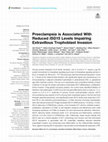
Frontiers in Cell and Developmental Biology
Among several interleukin (IL)-6 family members, only IL-6 and IL-11 require a gp130 protein homo... more Among several interleukin (IL)-6 family members, only IL-6 and IL-11 require a gp130 protein homodimer for intracellular signaling due to lack of intracellular signaling domain in the IL-6 receptor (IL-6R) and IL-11R. We previously reported enhanced decidual IL-6 and IL-11 levels at the maternal-fetal interface with significantly higher peri-membranous IL-6 immunostaining in adjacent interstitial trophoblasts in preeclampsia (PE) vs. gestational age (GA)-matched controls. This led us to hypothesize that competitive binding of these cytokines to the gp130 impairs extravillous trophoblast (EVT) differentiation, proliferation and/or invasion. Using global microarray analysis, the current study identified inhibition of interferon-stimulated gene 15 (ISG15) as the only gene affected by both IL-6 plus IL-11 vs. control or IL-6 or IL-11 treatment of primary human cytotrophoblast cultures. ISG15 immunostaining was specific to EVTs among other trophoblast types in the first and third trimest...
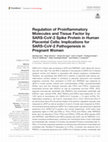
Frontiers in Immunology
SARS-CoV-2 infects cells via binding to ACE2 and TMPRSS2, which allows the virus to fuse with hos... more SARS-CoV-2 infects cells via binding to ACE2 and TMPRSS2, which allows the virus to fuse with host cells. The viral RNA is detected in the placenta of SARS-CoV-2-infected pregnant women and infection is associated with adverse pregnancy complications. Therefore, we hypothesize that SARS-CoV-2 infection of placental cells induces pro-inflammatory cytokine release to contribute to placental dysfunction and impaired pregnancy outcomes. First, expression of ACE2 and TMPRSS2 was measured by qPCR in human primary cultured term cytotrophoblasts (CTBs), syncytiotrophoblast (STBs), term and first trimester decidual cells (TDCs and FTDCs, respectively), endometrial stromal cells (HESCs) as well as trophoblast cell lines HTR8, JEG3, placental microvascular endothelial cells (PMVECs) and endometrial endothelial cells (HEECs). Later, cultured HTR8, JEG3, PMVECs and HEECs were treated with 10, 100, 1000 ng/ml of recombinant (rh-) SARS-CoV-2 S-protein ± 10 ng/ml rh-IFNγ. Pro-inflammatory cytokines...
Reproductive Sciences, 2021
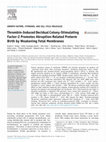
The American Journal of Pathology, 2020
Preterm premature rupture of membranes (PPROM) and thrombin generation by decidual cell eexpresse... more Preterm premature rupture of membranes (PPROM) and thrombin generation by decidual cell eexpressed tissue factor often accompany abruptions. Underlying mechanisms remain unclear. We hypothesized that thrombin-induced colony-stimulating factor-2 (CSF-2) in decidual cells triggers paracrine signaling via its receptor (CSF2R) in trophoblasts, promoting fetal membrane weakening and abruption-associated PPROM. Decidua basalis sections from term (n Z 10), idiopathic preterm birth (PTB; n Z 8), and abruption-complicated pregnancies (n Z 8) were immunostained for CSF-2. Real-time quantitative PCR measured CSF2 and CSF2R mRNA levels. Term decidual cell (TDC) monolayers were treated with 10 À8 mol/L estradiol AE 10 À7 mol/L medroxyprogesterone acetate (MPA) AE 1 IU/mL thrombin pretreatment for 4 hours, washed, and then incubated in control medium with estradiol AE MPA. TDC-derived conditioned media supernatant effects on fetal membrane weakening were analyzed. Immunostaining localized CSF-2 primarily to decidual cell cytoplasm and cytotrophoblast cell membranes. CSF-2 immunoreactivity was higher in abruption-complicated or idiopathic PTB specimens versus normal term specimens (P < 0.001). CSF2 mRNA was higher in TDCs versus cytotrophoblasts (P < 0.05), whereas CSF2R mRNA was 1.3 Â 10 4 efold higher in cytotrophoblasts versus TDCs (P < 0.001). Thrombin enhanced CSF-2 secretion in TDC cultures fourfold (P < 0.05); MPA reduced this effect. Thrombin-pretreated TDC-derived conditioned media supernatant weakened fetal membranes (P < 0.05), which MPA inhibited. TDC-derived CSF-2, acting via trophoblast-expressed CSFR2, contributes to thrombininduced fetal membrane weakening, eliciting abruption-related PPROM and PTB.
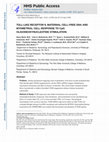
American Journal of Reproductive Immunology, 2019
ProblemAmong mechanisms triggering onset of parturition, it has been recently postulated that Tol... more ProblemAmong mechanisms triggering onset of parturition, it has been recently postulated that Toll‐Like Receptor (TLR)9 engagement by cell‐free DNA (cfDNA) triggers inflammation, myometrial contractions, and labor in absence of infection. The current study evaluated whether direct (myometrial) or indirect (decidual) TLR9 engagement enhances human myometrial contractility.Method of StudyToll‐like receptor 9 expression and cellular localization were surveyed by immunohistochemistry of placenta, fetal membranes, and myometrium in term (gestational age [GA]: >37 weeks) labor (TL, n = 7) or term non‐labor (TNL, n = 7) tissues. Non‐pregnant myometrium (n = 4) served as reference. TLR9 mRNA expression relative to other TLRs was evaluated through the mining of an RNA‐seq dataset and confirmed by RT‐PCR. Immortalized human myometrial cells (hTERT‐HM) were treated with incremental concentrations of TLR9 agonist ODN2395, TNF‐α, or LPS. Secreted cytokines were quantified by multiplex immunoa...






Uploads
Papers by Charles Lockwood